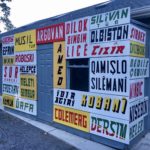KUŞU, 2016, 3 channel video installation
From The Big Story to The Small Story: Kuşu
Vahap Avşar is amongst the first artists in Turkey to perform intervention art – albeit without labelling it as such. Since the early 90s, Avşar has been producing political works through artistic interventions on important cultural and political symbols. In a way, he pokes small holes into the ‘big story’ that he was born into with political touches, and shakes the meanings of cultural / political images. In this sense, he is in an artistic war with hegemonic images and their meanings. It is possible to say that he undertakes a sort of disclosure operation for images which he has picked out from Turkey’s injured sociology. The postcards that he exhibited at Salt were also works of this kind. He had enlarged found postcards and displayed a calamitous historical fragment of Turkey, and had created a ‘big story’ from it.
In his last solo exhibition that opened in MARSIstanbul, Avşar focuses on the small story rather than the big one: he tries to make visible things that are non-hegemonic, decentralized and even invisible. In this exhibition, which is composed of three video works produced as a result of a ‘journey back to the roots’, the artist focuses on two small stories taking place in the village of Kuşu, where his father was born. Here, we see that Avşar has moved from widespread images to inconspicuous images and stories that would not be a part of the world’s history if he had not chosen them. This transition from large to small, from macro- to micro- also contains, of course, macro-sociological vibrations.
Kuşu is an Alewi village in the city of Malatya. In two separate video works, Avşar tells the stories of two people, a shepherd and a beekeeper, who live in this area. A third video placed in-between the other two gives the general plan view of the village. Thus, these two small scale-individual stories also sit within the greater landscape.
So what do these two stories tell? The first is the story of Ali, a shepherd. As Avşar follows Ali and his herd, a familiar story about the human-nature-animal relationship – at least as it exists in the minds of ‘urban’ individuals – is spontaneously written. Speaking amidst the sounds of the goats in the herd and the buzzing winds of the mountain hills, Ali is in a way lost in the sounds of animals and nature. You can also say that he is at one with those sounds. A primitive existence – in a positive sense – that is at one with animals and nature. This state of existence evokes purity and silence, and tells of a spontaneous bond that man can no longer establish with nature. This is achieved through following a figure among these sounds, without saying too much.
In the story of Barış, who is a beekeeper, there is the opposite sense of the ‘silence’ that is present in Ali’s story – or of the prevalence of nature’s sounds. Unlike Ali, Barış is not a ‘natural’ and spontaneous part of the environment in which he exists, but a character who questions what is happening, the people, the nature, the politics, the city, the village and in turn existence in the world. The red sickle-hammer he draws on his beekeeper overalls turns Barış into a character out of a novel or movie. Questioning the relations of production and consumption, balances and imbalances in society, politics, the state and everything else
while dealing with bees on the one hand, Barış sometimes resembles a Soviet astronaut with a high political consciousness which inevitably turns him into a ‘fantastic-political’ figure. This astronaut-like, sociologist-beekeeper’s statements contain foundational insights into the political situation in Turkey. Thus, Avşar passes from the small-person – or the small story – to the big story.
The fact that Kuşu an Alevi village also makes these small-stories inevitably lead to ‘big’ connotations. Vahap Avşar, who has once carried a statue of Prophet Ali in the streets of New York to show the current state of the Alevis and the fact that there is another, non- Sunni interpretation of Islam, forms sentences in these works about ‘the minorities’ and the ‘great landscape’ without using big words. It is also meaningful that the names of the two characters in these sentences are Ali and Barış. They are meaningful within themselves, as two expressions of longing.
The fact that Vahap Avşar does not fall into the sneaky auto-orientalism trap where such ‘back-to-the-roots’ videos can fall, and that he does not surrender to a disturbing ‘social anthropologist’ view, also reinforces the political stance and emotional impact of these works. This is an exhibition of strength and clarity that can refresh your belief in life, nature and politics. Here, I am speaking from experience.
Ahmet Ergenç













